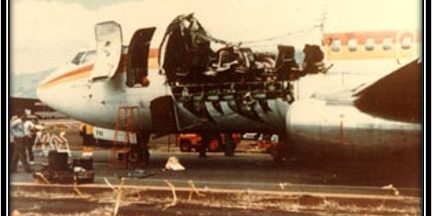36 Years ago Today in Aviation History
Contributor: Barry Fetzer
Sources: History.com

Courtesy FAA.
Where were you 36 years ago today? Hopefully not on Aloha Airlines Flight 243.
According to History.com, “On April 28, 1988, a seemingly routine, 35-minute flight from Hilo to Honolulu turned into terror when an 18-foot-long section of the upper fuselage suddenly tore off Aloha Airlines Flight 243. The explosive decompression and roof loss swept flight attendant Clarabelle “C.B.” Lansing out of the Boeing 737, sent freezing winds of hurricane force through the cabin, and left passengers in the first five rows of the plane completely exposed to the sky.
“Miraculously, Captain Robert Schornstheimer landed the plane in Maui with no further deaths.
“The bizarre incident happened about 20 minutes into the flight from Hilo International Airport to Honolulu, at 24,000 feet with 95 passengers and crew members on board. The 300-m.p.h. wind was so noisy that the pilots had difficulty communicating in the cockpit, and flight attendants couldn’t get into the cockpit to see if they were even alive. Passengers under the missing roof had no access to oxygen and became incapacitated by hypoxia.

A graph showing the missing fuselage area of the Boeing 737. Courtesy FAA.
“Passenger William Flanigan, traveling on an anniversary trip to Hawaii with his wife, told The Washington Post that flight attendant Lansing was just announcing last call before descent when a gaping hole opened, explosively, in the roof. ‘She was just handing my wife a drink,’ he said. ‘And then, whoosh! She was gone. Their hands just touched when it happened.’
“Captain Schornstheimer began an emergency descent into Kahului Airport on Maui, flying the crippled jet over mountains to get there. Passengers later interviewed felt certain they would die, but the captain successfully made the landing after flying 13 terrifying minutes in the damaged aircraft. “There were wires hanging all around, wrapped around me,” said Flanigan. ‘I remember yelling “I’m being electrocuted.” I really thought I was being burned alive.’ His wife Joy, badly injured by flying metal debris and flailing wires, was one of 60-some passengers treated at Maui’s Memorial Hospital after the landing.
“‘This is one of the most remarkable flying events in history. No airplane has ever landed with this amount of damage,’ Greg Feith, air crash investigator, said in an interview on the TV series Air Disasters. ‘The only thing that was holding the forward section cockpit to the rest of the fuselage were the floor beams. Basically, they were hanging by a thread.’
Editor’s comment: Mr. Feith must not have been considering combat damage during WWII to B-17’s and other bombers when he made his, “No airplane has ever landed with this amount of damage” statement, above. In no way, though, is this comment intended to lessen Captain Schornstheimer’s flying skills that enabled him to land such a badly damaged commercial aircraft.
“A National Transportation Safety Board investigation determined that the airline’s maintenance crew did not detect significant disbanding and fatigue damage on the plane’s skin lap splice. As a result of the crash, Congress passes the Aviation Research Act, which increased FAA oversight.”







